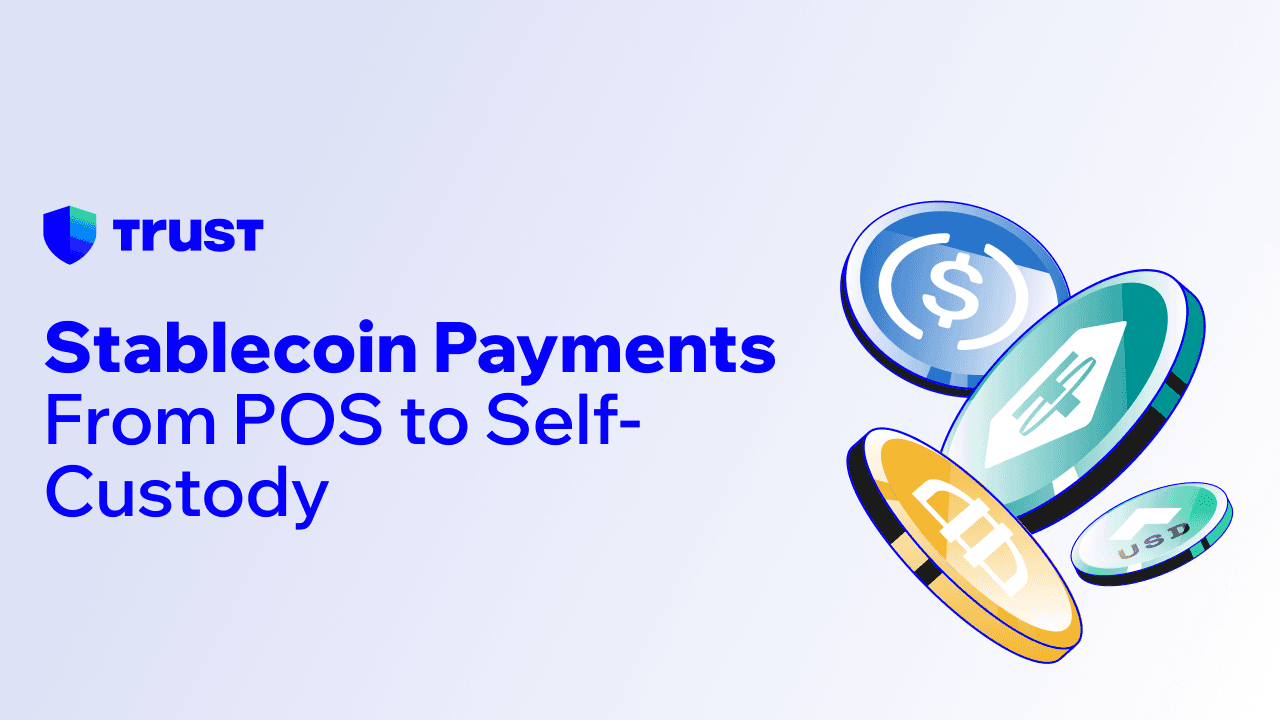스테이블코인
Stablecoin Payments: From POS to Self-Custody
게시물 공유
요약
Discover how stablecoin payments are transforming POS systems and learn to transition from merchant payments to secure self-custody wallets like Trust Wallet.

Key Takeaways:
Stablecoin payments are revolutionizing point-of-sale systems by offering fast, low-cost transactions for merchants and consumers.
The regulatory landscape for digital payments is evolving rapidly, with clearer frameworks emerging for POS systems and crypto payments.
Self-custody wallets like Trust Wallet provide complete control over your stablecoin payments while maintaining compliance with evolving regulations.
The world of digital payments is undergoing a seismic shift. Stablecoin payments are no longer confined to trading platforms or DeFi protocols. They're making their way into everyday commerce through POS systems, creating new opportunities for merchants and consumers. The journey from traditional payment processing to self-custody solutions represents more than just technological advancement - it's a fundamental change in how we think about money, control, and financial sovereignty.
The Rise of Stablecoin Payments in Point-of-Sale Systems
POS systems across the globe are beginning to integrate stablecoin payments as merchants recognize the benefits of instant settlement and reduced fees. Unlike traditional credit card processing that can take days to settle and charge 2-3% in fees, stablecoin payments offer near-instant finality at a fraction of the cost.
USDT and USDC have emerged as the leading choices for merchant adoption. These stablecoins maintain their dollar peg through different mechanisms, providing merchants with price stability while offering the speed and efficiency of blockchain technology. Coffee shops in Miami, restaurants in Singapore, and retail stores in Dubai are already accepting stablecoin payments through compatible POS systems.
The integration process has become remarkably simple. Modern POS systems can generate QR codes that customers scan with their mobile wallets. The payment processes instantly, and merchants receive confirmation within seconds. This efficiency has made stablecoin payments particularly attractive for businesses in regions with volatile local currencies or expensive cross-border payment infrastructure.
Navigating the Evolving Regulatory Landscape
The regulatory landscape for stablecoin payments is rapidly maturing. Governments worldwide are recognizing the need for clear frameworks that protect consumers while enabling innovation. The European Union's Markets in Crypto-Assets (MiCA) regulation has set a precedent for comprehensive stablecoin oversight, requiring issuers to maintain full reserves and provide regular audits.
In the United States, regulatory clarity is emerging through various channels. For POS systems accepting stablecoin payments, compliance requirements vary by jurisdiction but generally focus on anti-money laundering (AML) and know-your-customer (KYC) procedures. Financial institutions are adapting by developing compliant infrastructure, with banks partnering with fintech companies to offer stablecoin custody services.
The key for businesses considering stablecoin payments is staying informed about local regulations and working with providers who prioritize compliance. Requirements for transparent reserve management ensure that USDT and USDC maintain their stability and redemption guarantees, building confidence among merchants and consumers adopting stablecoin payments.
Setting Up Your Self-Custody Wallet for Stablecoin Payments
Transitioning to self-custody doesn't mean abandoning convenience or security. Trust Wallet demonstrates how self-custody wallets can provide institutional-grade security while maintaining user-friendly interfaces. Setting up your wallet for stablecoin payments involves simple steps that put you in complete control of your digital assets.
Download Trust Wallet
Download and install Trust Wallet from official sources and complete the wallet creation process. Your seed phrase becomes your master key - store it securely offline. This backup ensures you can recover your wallet even if your device is lost or damaged. The setup process takes less than five minutes and provides immediate access to stablecoin payments.

Create a New Wallet
Here’s a quick look at how to create a crypto wallet using Trust Wallet:
Open the app and tap "Create a new wallet."
The app will generate a unique 12-word seed phrase for you.
Write the seed phrase on paper in the correct order.
Verify the seed phrase by entering the words in the correct sequence when prompted.
Set a PIN or biometric lock for additional security.
 Remember, once you've set up your wallet, it's important to keep your seed phrase safe and never share it with anyone.
Remember, once you've set up your wallet, it's important to keep your seed phrase safe and never share it with anyone.
Fund Your Wallet
Fund your wallet with USDT or USDC through the integrated “buy stablecoin” feature or transfer from exchanges. Trust Wallet supports multiple networks including Ethereum and BNB Chain, giving you flexibility in managing your stablecoin payments. The wallet automatically detects incoming transactions and updates your balance in real-time.
Security and Best Practices
Self-custody comes with responsibility, but following established best practices makes secure stablecoin payments achievable for everyone. Your private keys never leave your device when using Trust Wallet, ensuring that even if the company's servers were compromised, your funds remain secure. Enable biometric authentication for quick access while maintaining security. Modern self-custody wallets balance convenience with protection through features like transaction signing prompts and spending limits. Never share your seed phrase or private keys with anyone, and be cautious of phishing attempts that try to trick you into revealing sensitive information.
Closing Thoughts
The evolution from traditional POS systems to self-custody stablecoin payments represents a fundamental shift toward financial sovereignty. While the regulatory landscape continues developing, early adopters who understand both the technology and compliance requirements position themselves advantageously for the future of digital commerce. Self-custody wallets like Trust Wallet bridge the gap between cutting-edge blockchain technology and practical payment solutions. The ability to make instant, low-cost stablecoin payments while maintaining complete control over your assets offers a compelling alternative to traditional payment systems.
Disclaimer: Content is for informational purposes and not investment advice. Web3 and crypto come with risk. Please do your own research with respect to interacting with any Web3 applications or crypto assets. View our terms of service.
Join the Trust Wallet community on Telegram. Follow us on X (formerly Twitter), Instagram, Facebook, Reddit, Warpcast, and Tiktok
Note: Any cited numbers, figures, or illustrations are reported at the time of writing, and are subject to change.




